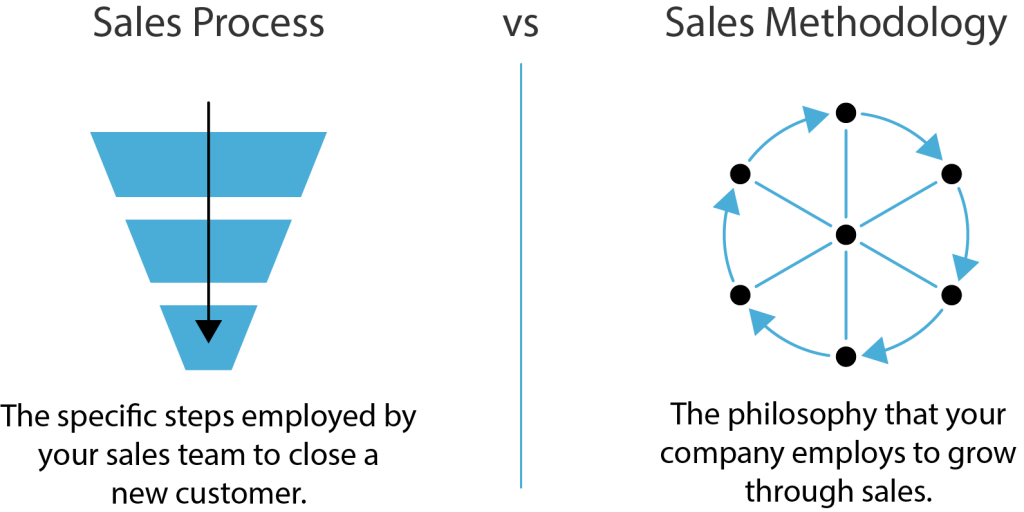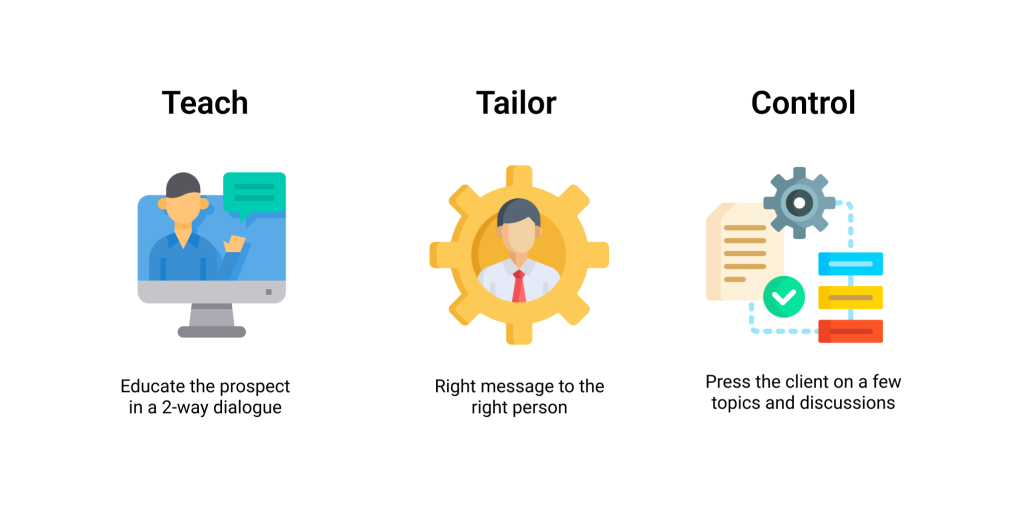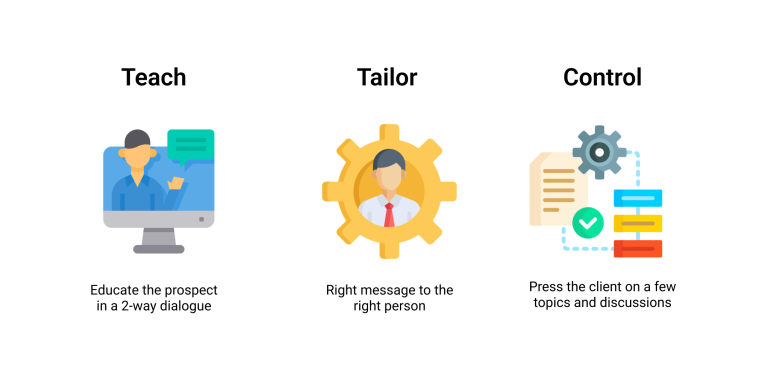Sales methodologies play an important role in the nearly every selling situation. It is a common approach that allows salespeople to follow a consistent structure, understand best practices and accelerate learning. The specific sales methodology is only relevant to the buying and selling situations of any individual company as everyone needs to tailor their sales motions to their markets, industries etc. Nothing in sales stands still so salespeople must constantly absorb information on with new products, trends, competitors and importantly changing buyer preferences and influencers on their decisions.
So, you could say that a sales methodology involves the application of fundamental sales skills and processes by salespeople. It emphasizes the importance of discovering, communicating, and delivering business value consistently across the entire buyer’s journey. However, for them to be effective, it’s essential every salesperson fully understands and adopts them.
No matter which of the sales methodologies you select for your business, selling is and will always require
1) Patience
2) Consistency and Communication
3) Beneficial touch points
4) Comprehensive approach with value propositions
5) Bringing real value
6) Commitments to act
One of the simplest sales methodologies is the three T’s: Teach the customer something valuable, enough to motivate them to act, Tailor the sales engagement to each particular customer and situation, and Take control of the conversations by gain commitments to move forward (otherwise get out of there!).
Sales Methodology Training – Why you need it.
OK, we can now say that the primary role of a sales methodology is that it provides a common language throughout the sales organization. When a sales methodology has been effectively implemented, salespeople, managers and executives all understand the selling motions and concepts adopted by the company. This helps everyone communicate and measure their progress on a sale based on deal potential and qualification criteria of an opportunity. The success of sales methodologies is usually determined by how well every salesperson is trained on it and by how much the sales methodology is consistently used by salespeople in the sales process.
In today’s noisy and highly competitive landscape, to get a customer to listen, to get on their calendar, keep their attention, win deals, and build loyalty, salespeople need to understand and deliver what today’s buyers want. Business and by default sales success depends on:
• Knowing and Knowledge. Buyers expect you to understand their business, markets, direction, challenges, processes, and relationship history.
• Provide real value. Every single interaction is evaluated to determine if it is worth the time or effort. Buyers want ideas, insights, leadership, and guidance to assess if the effort is worth the reward. Buying and I mean all buying is a change management issue, does changing makes sense?
• Make buying easy. Salespeople are expected to provide what buyers need, when they want it, and how they want it, quickly.

Sales methodologies that have been adopted.
While there are various sales stages, using sales methodologies as guidelines can better prepare your teams to navigate through the selling process.
The Challenger Sale
This sales methodology tells us that there are five types of salespeople. Namely, the Challenger, the Hard Worker, the Lone Wolf, the Relationship Builder, and the Problem Solver. It tells us that these set of profiles can be used to determine how salespeople (or even the company) interact with customers. A method where each salesperson teaches the prospect something about their business, tailors their pitch to match the customer concerns, and takes control of the sales process. The challenger approach is for salespeople to understand what brings customers value and leverage that information to deliver a hard-hitting pitch. This sales methodology is not about relationship building and works best in disruptive technologies and highly skilled salespeople.
SPIN Selling
The term “SPIN” stands for the four different types of questions salespeople address with potential customers through this method: Situation, Problem, Implication, Need/Payoff. It became popular in the in 90’s and early 2000’s mainly in larger companies. Oracle used this sales methodology. It is mainly deployed in sales situations involving key accounts, high value ticket items or the more “complex sale”.
Situation: Understanding the prospect’s situation at the moment. This can be conducted through a questionnaire, a call, or a meeting.
Problem: This is where sales reps can dig into the actual prospect’s issues.
Implication: Sales representatives run a series of questions to the prospect so that the latter can explore the consequences of not solving their issues.
Need-payoff: In this step, the prospect considers how the resolution of their problem could help change their situation.
SPECS
SPECS is another of the sales methodologies. The term SPECS means Status, Problem, Effect, Confirmation and Solution.
Status (understand your buyer types, markets, current vendors etc)
Problem (where is the pain, is the pain accepted etc)
Effect (problem impact, objection handling, build trust, considered sales conversations)
Confirmation (Yes commitment bond, motivated to act, clear steps)
Solution (confirming and closing the sale)
SNAP Sales Methodology
The SNAP sales methodology which stands for:
Keep it Simple: Salespeople must make it clear to prospects how their solution can change their current situation (the status quo).
Be invaluable: Theen showcase the value and make it easy for the product or service at stake to stand out.
Always Align: It all comes down to aligning business objectives with core beliefs. Salespeople need to persuade people to work with them.
Raise Priorities: Buyers have priorities. Salespeople need to tap into these priorities and get on the buyer’s priority list.
Sandler
Another of the popular sales methodologies is the Sandler selling system. This system focuses on creating genuine, mutually beneficial relationships between the salesperson and the customer. It leans towards a collaborative approach with salespeople acting more as trusted advisors than traditional salespeople.
The seven steps every sales rep should follow with the Sandler methodology are:
Bonding and rapport building: During this stage, open and honest communication between the seller and the prospect is encouraged.
Up-front contracts: Establishing roles and expectations is what comes next. It’s crucial to set clear rules to make the prospect comfortable.
Pain: This is the qualification stage, where the sales rep discovers the prospect’s pain points and how the product/service at stake can help solve them.
Budget: This step allows sellers to understand whether the prospect can afford the product/service being discussed and if they can invest the necessary time, effort, and resources.
Decision: The seller explores how the prospect wants the buying process to move on.
Fulfilment: Salespeople may now present how their product/service can help the prospect fix their issues. Any request the prospect has, can now be fulfilled.
Post-sell: At this point, both parties seal the deal.
MEDDICC
This sales methodology centres around a six-step process to guide salespeople gather the most critical information and then move through the qualification and selling process. The acronym MEDDIC stands for metrics, economic buyer, decision criteria, decision process, identify pain, competition, and champion.
It includes:
• Metrics: What is the prospect looking to gain from what you’re selling? How do they define success?
• Economic Buyer: Who in the business is the true decision maker?
• Decision Criteria: What criteria does the company you’re pitching use to make decisions? Do they value cost, ease of use,
integration, etc.?
• Decision Process: What’s the full decision-making process from approval to contract signing?
• Identify Pain: What are the prospect’s driving pain points?
• Competition: Who am I up against both external and internal workarounds?
• Champion: Who, internally, can champion you?
Similar to SPIN, MEDIC is mainly deployed in large for enterprise sales with high complexity.
Consultative Selling
Consultative selling methodologies is a combination of needs-focussed selling skills, marketing understanding, business management, financial acumen and relationship building. Modern salespeople need to understand the buyer. Doing so means forming an accurate diagnosis of their problem. This insight builds credibility thereby fostering trust. In consultative selling, these steps are critical in earning the right to ask the incisive questions that bring about a dialogue.
Step 1. Display conviction, confidence, and curiosity: Developing sales skills and behaviors that demonstrate your commitment to the relationship and attentiveness to the details coming from the customer.
Step 2. Connect to the emotional side of buying: Salespeople need to be able to empathize. Doing so means not simply acknowledging the customer’s challenges but seeking to feel what they feel and understand what they think.
Step 3. Foster openness: Get the customer talking. You cannot move the sale forward without both sides contributing to the conversation.
Step 4. Open up customer thinking: Remember that insightful questions are just as effective at getting a customer to think different about sharing ideas or insights.
Step 5. Maintain seller & buyer alignment: Keep the customer in the game. If scepticism or obscurity is left unrecognized, it will grow unchecked until finally killing the sale.
Customer-centric
Customer Centric Selling focuses on the buyer-seller relationship and helping sales rep position themselves as helpful collaborators rather than pushy salespeople.
The eight tenets of Customer Centric Selling include:
• Communicating vs. making presentations
• Asking questions vs. offering opinions
• Providing a solution to your prospect’s main pain point vs. solely relationship-building
• Targeting decision-makers vs. doers
• Promoting how the product is being used vs. the standalone product
• Focusing on being the best seller—not the busiest
• Working within the prospect’s timeline vs. your own
• Empowering prospects to buy vs. convincing them to buy
The customer-centric sales methodology puts your customer first. Sales reps elevate their prospects and empathize with their needs every step of the way. During this approach, salespeople must adapt to any specific circumstances of the prospect by encouraging a two-way discussion, adjusting the timelines accordingly, and using a problem-solving method.

Sales Methodologies Conclusion
AI, technology, competition, and multiple stakeholders in the buying group have all changed the buyer’s behavior. The salespeople getting the sale across the line are those who recognize these changes and adapt accordingly.
The demands and speed (or lack of) means that salespeople are constantly under pressure to deliver. On the one side they have to navigate the buyer’s sometimes meandering journey and on the other side the need to build sales pipeline and bring in revenue. To be successful in today’s selling environment, salespeople must acquire the selling skills to not only influence and also move in tandem with the buyer’s journey towards a conclusion. To build the skills to maximize their ability to win deals, to open up genuine sales conversations, to build relationships, to understand and show empathy and, most importantly, to serve the customer.
This is why sales methodologies are important and why believe salespeople will benefit from having a clear sales methodology, which includes sales management, sales training, and sales enablement. Remember, salespeople can only expect to benefit from gains once they see changes in their sales behavior. Doing so means asking what it really means to be customer focused. A sales force that strives to be genuine, works to a process and plan, invokes customer participation, that creates motion and emotion are all part of a winning plan.
Note: Your sales methodology doesn’t have to be overly complicated or long winded. It is about setting up salespeople for success with a repeatable method to bring the buyer on a journey that is relevant to what you sell. Watch more Digital Sales Institute videos.


